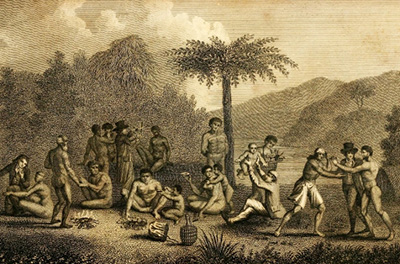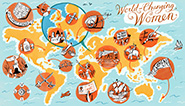| Marie-Louise Girardin | France/new world | 1754-94 | Exploration |
 A drawing by Labillardiere of the expedition Girardin undertook.
Even in the radical atmosphere of revolutionary France, there were few options open to a young woman who had given birth to a child out of wedlock and had then been abandoned by the father. Unable to see a familial or economic future for herself at home, Marie-Louise Victoire Girardin escaped parental disgrace by disguising herself as a man. She joined a scientific expedition to Tasmania as a ship’s steward, calling herself Louis Girardin.
A drawing by Labillardiere of the expedition Girardin undertook.
Even in the radical atmosphere of revolutionary France, there were few options open to a young woman who had given birth to a child out of wedlock and had then been abandoned by the father. Unable to see a familial or economic future for herself at home, Marie-Louise Victoire Girardin escaped parental disgrace by disguising herself as a man. She joined a scientific expedition to Tasmania as a ship’s steward, calling herself Louis Girardin.
Girardin was born in 1754. Described as petite, plain and very youthful in appearance, she was able to maintain her assumed identity because, as steward, she had a cabin to herself. Although her shipmates appear to have suspected that she was a woman and to have goaded her about it, Girardin persevered in her story, going as far as to challenge a colleague to duel over the matter, in which she was injured.
Whilst the primary objective of the expedition was to search (unsuccessfully) for a Frenchman called La Pérouse who had disappeared after leaving Botany Bay in 1788, it also had a scientific purpose. The expedition made a number of important geographical discoveries, amassed a significant collection of natural history specimens and made some of the earliest ethnographic observations of the Aboriginal people of Tasmania. The expedition also visited Tenerife, the Cape of Good Hope, New Ireland, the Admiralty Islands, Ambon, Tongatapu, and Balade (New Caledonia) before being split along royalist and republican lines in the Dutch East Indies on hearing news of the execution of King Louis XVI.
Girardin died of dysentery in the Dutch transport Dordrecht in December 1794. The ship's surgeon then revealed her true gender. She was honoured in 2005 as the first female European visitor to set foot on the island.
 This article is part of the world-changing women collection. All the articles in this collection are specially produced for the How women changed the world interactive tour created to reveal the untold stories the history books left out.
This article is part of the world-changing women collection. All the articles in this collection are specially produced for the How women changed the world interactive tour created to reveal the untold stories the history books left out.
You can also view these articles without the interactive feature here.
Rate and Review
Rate this article
Review this article
Log into OpenLearn to leave reviews and join in the conversation.
Article reviews